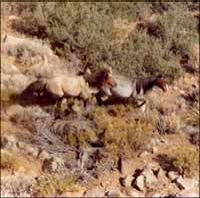
The Morgan horse is one of the earliest horse breeds developed in the United States. Tracing back to the foundation sire Figure, later named Justin Morgan after his best-known owner, Morgans served many roles in 19th-century American history, being used as coach horses and for harness racing, as general riding animals, and as cavalry horses during the American Civil War on both sides of the conflict. Morgans have influenced other major American breeds, including the American Quarter Horse, Tennessee Walking Horse and the Standardbred. During the 19th and 20th centuries, they were exported to other countries, including England, where a Morgan stallion influenced the breeding of the Hackney horse. In 1907, the US Department of Agriculture established the US Morgan Horse Farm near Middlebury, Vermont for the purpose of perpetuating and improving the Morgan breed; the farm was later transferred to the University of Vermont.The first breed registry was established in 1909, and since then many organizations in the US, Europe and Oceania have developed. There were estimated to be over 175,000 Morgan horses worldwide in 2005.
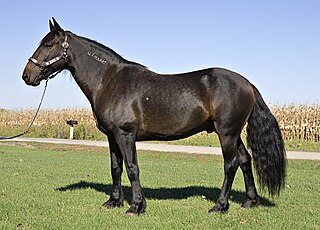
The mustang is a free-roaming horse of the Western United States, descended from horses brought to the Americas by the Spanish conquistadors. Mustangs are often referred to as wild horses, but because they are descended from once-domesticated animals, they are actually feral horses. The original mustangs were Colonial Spanish horses, but many other breeds and types of horses contributed to the modern mustang, now resulting in varying phenotypes. Some free-roaming horses are relatively unchanged from the original Spanish stock, most strongly represented in the most isolated populations.

Colonial Spanish horse is a term for a group of horse breed and feral populations descended from the original Iberian horse stock brought from Spain to the Americas. The ancestral type from which these horses descend was a product of the horse populations that blended between the Iberian horse and the North African Barb. The term encompasses many strains or breeds now found primarily in North America. The status of the Colonial Spanish horse is considered threatened overall with seven individual strains specifically identified. The horses are registered by several entities.

The Lusitano, also known as the Pure Blood Lusitano or PSL, is a Portuguese horse breed. Horses were known to be present on the Iberian Peninsula as far back as 20,000 BC, and by 800 BC the region was renowned for its war horses. The fame of the horses from Lusitania goes back to the Roman Age, which attributed its speed to the influence of the West wind, who was considered capable of fertilizing the mares. When the Muslims invaded Iberia in 711 AD, they brought Arabian horses with them that were crossed with the native horses, developing a horse that became useful for war, dressage and bull fighting. The Portuguese horse was named the Lusitano, after the word Lusitania, the ancient Roman name for the region that modern Portugal occupies. There are four main breed lineages within the breed today, and characteristics differ slightly between each line.

The Narragansett Pacer was one of the first recorded horse breeds developed in the United States. It emerged in the 18th century (1700s), and was theorized to have been bred from a mix of English and Spanish breeds, although the exact cross is unknown. The Pacer was associated with, and bred in, the state of Rhode Island and the area of New England; as horse breeding shifted to Kentucky and Tennessee in the late 1700s, it became extinct by the 20th century.

The National Show Horse originated as a part-Arabian cross between an American Saddlebred and an Arabian horse. It is now established as a separate breed, since the founding of a breed registry in August 1981. Registered animals today may be the offspring of registered NSH parents or may be a combination between an American Saddlebred, Arabian, and a National Show Horse. Non-NSH mares and stallions must be registered with their appropriate registries, and stallions who are Arabian or Saddlebred must additionally be nominated and approved by the NSHR board of directors. Although any combination of these three breeds may be used, as of December 1, 2009 there must be at least 50% Arabian blood in the horse to be registered, up to 99% Arabian blood.

The Azteca is a horse breed from Mexico, with a subtype, called the "American Azteca", found in the United States. They are well-muscled horses that may be of any solid color, and the American Azteca may also have Paint coloration. Aztecas are known to compete in many western riding and some English riding disciplines. The Mexican registry for the original Azteca and the United States registries for the American Azteca have registration rules that vary in several key aspects, including ancestral bloodlines and requirements for physical inspections. The Azteca was first developed in Mexico in 1972, from a blend of Andalusian, American Quarter Horse and Mexican Criollo bloodlines. From there, they spread to the United States, where American Paint Horse blood was added.
The Galiceno is a horse breed developed in Mexico, bred from horses brought from Spain by Hernán Cortés and other conquistadors. Although small in stature, they are generally considered a horse, rather than a pony, and are always solid-colored. In Mexico, they are an all-around horse, used for riding, packing and light draft. In the United States they are often used as mounts for younger competitors, although they are also found competing in Western events. The breed descends from horses brought from Spain to Mexico during the 16th century. Many of these horses escaped or were released and formed feral bands in the interior of Mexico, which were then captured by local inhabitants. They were also often used by Spanish missionaries to the American West, where they became some of the ancestors of the American Indian Horse. In 1958, these horses were first imported to the United States, and in 1959 a breed registry was formed. Many of the horses are also registered with the American Indian Horse Registry.
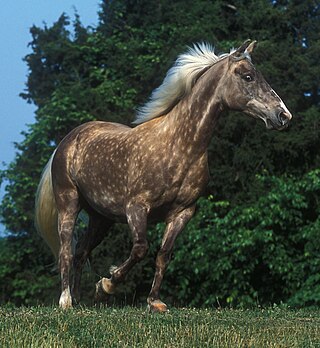
The Rocky Mountain Horse is a horse breed developed in the state of Kentucky in the United States. Despite its name, it originated not in the Rocky Mountains, but instead in the Appalachian Mountains. A foundation stallion, brought from the western United States to eastern Kentucky around 1890, began the Rocky Mountain type in the late 19th century. In the mid-20th century, a stallion named Old Tobe, owned by a prominent breeder, was used to develop the modern type; today most Rocky Mountain Horses trace back to this stallion. In 1986, the Rocky Mountain Horse Association was formed and by 2005 has registered over 12,000 horses. The breed is known for its preferred "chocolate" coat color and flaxen mane and tail, the result of the relatively rare silver dapple gene acting on a black coat, seen in much of the population. It also exhibits a four-beat ambling gait known as the "single-foot". Originally developed as a multi-purpose riding, driving and light draft horse, today it is used mainly for trail riding and working cattle.

The Spanish Mustang is an American horse breed descended from horses brought from Spain during the early conquest of the Americas. They are classified within the larger grouping of the Colonial Spanish horse, a type that today is rare in Spain. By the early 20th century, most of the once-vast herds of mustangs that had descended from the Spanish horses had been greatly reduced in size. Seeing that these horses were on the brink of extinction, some horseman began making efforts to find and preserve the remaining "Spanish Mustangs" drawing stock from feral and Native American herds, as well as ranch stock. The breed was one of the first to be part of a concerted preservation effort for horses of Spanish phenotype, and a breed registry was founded in 1957.

The Nokota horse is a feral and semi-feral horse breed located in the badlands of southwestern North Dakota in the United States. The breed developed in the 19th century from foundation bloodstock consisting of ranch-bred horses produced from the horses of local Native Americans mixed with Spanish horses, Thoroughbreds, harness horses and related breeds. The Nokota was almost wiped out during the early 20th century when ranchers, in cooperation with state and federal agencies, worked together to reduce competition for livestock grazing. However, when Theodore Roosevelt National Park was created in the 1940s, a few bands were inadvertently trapped inside, and thus were preserved.
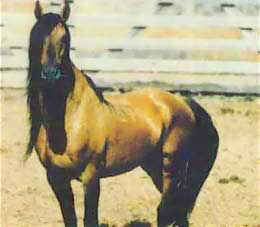
The Kiger mustang is a strain of mustang horse located in the southeastern part of the U.S. state of Oregon. The name applies only to wild-captured individuals and does not apply to their bred-in-captivity progeny, which are known as Kiger horses. The Bureau of Land Management (BLM) administers two herd management areas for Kiger mustangs in the Burns District—Kiger and Riddle Mountain, in the Steens Mountain area. DNA testing has shown that Kiger mustangs are descended largely from Spanish horses brought to North America in the 17th century, a bloodline thought to have largely disappeared from mustang herds before the Kiger horse populations were discovered in 1977.

The Florida Cracker Horse is a critically endangered horse breed from the state of Florida in the United States. It is genetically and physically similar to many other Spanish-style horses, especially those from the Spanish Colonial horse group, including the Banker horse of North Carolina, and the Carolina Marsh Tacky of South Carolina.
The Banker horse is a breed of semi-feral or feral horse living on barrier islands in North Carolina's Outer Banks. It is small, hardy, and has a docile temperament, and is genetically related to the Carolina Marsh Tacky of South Carolina and Florida Cracker Horse breeds through their shared Colonial Spanish horse and Iberian horse descent. The current population of wild Banker horses is estimated to be about 400.
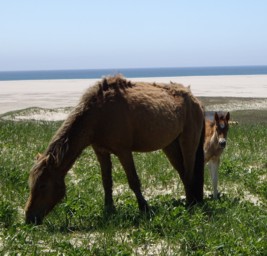
The Sable Island horse is a small feral horse found on Sable Island, off the coast of Nova Scotia, Canada. It is usually dark in colour. The first horses were released on the island in the late 1700s, and soon became feral. Additional horses were later transported to improve the herd's breeding stock. They were rounded up for private use and sale for slaughter, which by the 1950s had placed them in danger of extinction. During the 2018 study, the estimated population was 500 horses, up from the roughly 300 recorded in the 1970s.
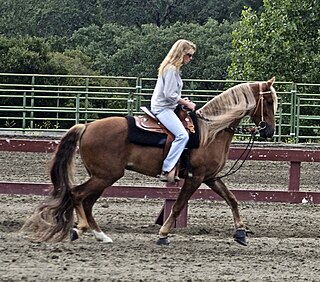
The Kentucky Mountain Saddle Horse is a horse breed from the U.S. state of Kentucky. Developed as an all-around farm and riding horse in eastern Kentucky, it is related to the Tennessee Walking Horse and other gaited breeds. In 1989 the Kentucky Mountain Saddle Horse Association (KMSHA) was formed, and in 2002, the subsidiary Spotted Mountain Horse Association (SMHA) was developed to register Kentucky Mountain Saddle Horses with excessive white markings and pinto patterns. Conformation standards are the same for the two groups of horses, with the main difference being the color requirements. The KMSHA studbook is now closed to horses from unregistered parents, although it cross-registers with several other registries, while the SMHA studbook remains open.
The Moyle is a rare riding horse breed suitable for ranch work and trail riding. It is believed to be descended from horses bred by Mormon settlers in Utah from Mustangs and Cleveland Bay lines, developed into its modern form by Rex Moyle. At present, there is no registry or breed association for these horses.
The Pryor Mountains Wild Horse Range is a refuge for a historically significant herd of free-roaming mustangs, the Pryor Mountain mustang, feral horses colloquially called "wild horses", located in the Pryor Mountains of Montana and Wyoming in the United States. The range has an area of 39,650 acres (160.5 km2) and was established in 1968 along the Montana–Wyoming border as the first protected refuge dedicated exclusively for mustangs. It was the second feral horse refuge in the United States. About a quarter of the refuge lies within the Bighorn Canyon National Recreation Area. A group of federal agencies, led by the Bureau of Land Management, administers the range.

The Pryor Mountain mustang is a substrain of mustang considered to be genetically unique and one of the few strains of horses verified by DNA analysis to be descended from the original Colonial Spanish horses brought to the Americas by the Spanish. They live on the Pryor Mountains Wild Horse Range located in the Pryor Mountains of Montana and Wyoming in the United States, and are the only mustang herd remaining in Montana, and one of sixteen in Wyoming. They are protected by the Wild and Free-Roaming Horses and Burros Act of 1971 (WFRHBA) and managed by the Bureau of Land Management (BLM), who has set the optimum herd number at 120 animals. Genetic studies have revealed that the herd exhibits a high degree of genetic diversity and a low degree of inbreeding, and BLM has acknowledged the genetic uniqueness of the herd. Pryor Mountain Mustangs are relatively small horses, exhibit a natural ambling gait, and domesticated Pryor Mountain mustangs are known for their strength, sure-footedness and stamina. The Pryor Mountains Wild Horse Range is one of the most accessible areas to view feral horse herds in the United States and tourism to the area has increased in recent years.

The Ojibwe Horse, also known as the Lac La Croix Indian Pony and Lac La Croix “Indian” or “Indigenous” pony is a semi-feral Canadian horse breed developed by the Ojibwe people. The population became critically low; and, by 1977, only four mares remained. To preserve the breed, these mares were crossed with Spanish Mustang stallions. The modern breed name derives from the Lac La Croix First Nation of Ontario, where the horses were last found in the wild. Historically, the breed was also found in Minnesota.
